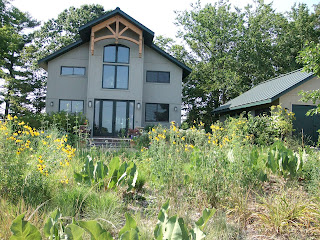NATIVE PLANTS FOR BEGINNERS
Modified by Karma Grotelueschen, PlannedScapes Native Landscape Design
From list by The Greater DuPage Chapter of Wild Ones
www.for-wild.org/chapters/dupage
Perennials for Sun (some can take part shade too)
Short—to 18”
Allium cernuum, nodding wild onion
Coreopsis palmata, prairie coreopsis *
Dalea (Petalostemum) purpurea, purple prairie clover
Dodecatheon meadia, shooting star
Tradescantia ohiense, Ohio spiderwort
Zizia aurea, golden Alexander
Medium—18” to 36”
Asclepias incarnata, swamp milkweed
Asclepias tuberosa, butterfly milkweed, prefers well drained soil, may not last in clay
Aster oblongifolia, aromatic aster
Echinacea pallida, pale purple coneflower
Liatris aspera, rough gayfeather
Liatris cylindrical, cylindrical gayfeather
Liatris pychnostachya, prairie blazing star
Parthenium integrifolium, wild quinine
Penstemon digitalis, foxglove beard tongue
Pycnanthemum virginianum, common mountain mint
Rudbeckia subtomentosa, sweet black-eyed Susan
Solidago ohiensis, Ohio goldenrod
Solidago riddellii, Riddell’s goldenrod
Tradescantia ohiensis, Ohio spiderwort
Tall—over 36”
Aster nova-angliae, New England aster
Baptisia leucantha, white wild indigo
Coreopsis tripteris, tall coreopsis
Echinacea purpurea, purple coneflower
Eryngium yuccifolium, rattlesnake master
Monarda fistulosa, beebalm, wild bergamot
Ratibida pinnata, yellow coneflower, gray-headed coneflower
Silphium laciniatum, compass plant
Silphium terebinthinaceum, prairie dock
Solidago rigida, stiff goldenrod
Grasses and Sedges for sun (some can take part shade too)
Short—to 18”
Carex pensylvanica, Penn sedge, common oak sedge
Carex vulpinoidea, brown fox sedge
Sporobolus heterolepis, prairie dropseed – best landscape edging grass
Medium—18” to 36”
Panicum virgatum, switch grass, can be aggressive so use sparingly
Schizachyrium scoparium, little bluestem, prefers well drained soil, may not last in clay
Tall—over 36”
Andropogon gerardii, big bluestem, can be aggressive so use sparingly
Sorghastrum nutans, Indian grass, can be aggressive so use sparingly
Perennials for Shade (some can take part sun too)
Aquilegia canadensis, wild columbine
Asarum canadense, wild ginger
Aster shorti, Short’s aster
Athyrium filix-femina var. michauxii, lady fern
Cimicifuga racemosa, Black cohosh
Geranium maculatum, wild geranium
Mertensia virginiana, Virginia bluebells
Podophyllum peltatum, Mayapple
Polemonium reptans, Jacob’s ladder
Polygonatum canaliculatum, Solomon’s seal
Sanguinaria canadensis, bloodroot
Smilacina racemosa, Solomon’s plume
Solidago flexicaulis, zig-zag goldenrod
Stylophorum diphyllum, celandine poppy
Grasses and Sedges for Shade (some can take part sun too)
Short—to 18”
Carex gracillima, purple-sheathed graceful sedge
Carex grayi, common bur sedge
Carex rosea, curly-styled wood sedge
Medium—18” to 36”
Chasmanthium latifolium, spike grass, Northern sea oats
Hystrix patula, bottle-brush grass
Shrubs for Dry Soils
Corylus americanus, American hazelhut
Lonicera prolifica, yellow honeysuckle
Rhus aromatica, aromatic sumac
Rhus aromatica “Gro-Low”, cultivar for use where low landscaping is needed
Viburnum acerifolium, maple-leaved viburnum
Shrubs for Medium Soils
Aronia melanocarpa, black chokeberry
Hamamelis virginiana, witch hazel
Hamamelis vernalis, spring witch hazel
Rosa setigera, Illinois rose
Rubus odoratus, purple-flowering raspberry
Sambucus canadensis, common elderberry
Viburnum dentatum, Arrowwood viburnum
Viburnum prunifolium, black haw viburnum
Shrubs for Moist Soils
Cephalanthus occidentalis, buttonbush
Cornus stolonifera (sericea), red-osier dogwood
Lindera benzoin, spice bush
Physocarpus opulifolius, ninebark
Small Trees for Colorful Accent
Amelanchier laevis, Allegheny shadblow
Amelanchier grandiflora, Serviceberry
Carpinus caroliniana, musclewood (moist)
Cercis canadensis, red bud
Cornus alternifolia, pagoda dogwood
Large Trees for Making Shade
Acer saccharum, sugar maple
Acer rubrum, red maple
Gymnocladus dioica, Kentucky coffee tree
Liriodendron tulipifera, tulip tree
Quercus macrocarpa, bur oak
Quercus muhlenbergii, chinquapin oak
Taxodium distichum, bald cypress (moist)
Tilia americana, American linden, basswood




















